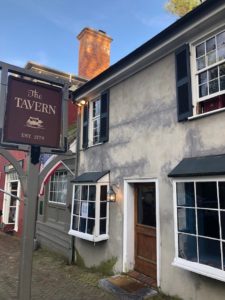
Presidential elections are enough to drive one to drink.
And back in the 18th and 19th centuries, those drinks were often provided by the candidates themselves until the temperance movement and prohibition emptied the glass. Until then, voters, except for the ladies, could stroll into the local tavern on Election Day and indulge in strong drink and hearty plates.
Thankfully, times have changed. Women have the right to vote. Taverns and bars, which couldn’t sell drinks on Election Day until the polls had closed, now can.
As for those historic taverns where America’s founding fathers and patriots gathered, many still exist, preserved for anyone of legal age to venture in to enjoy a pint, with or without hearty plate. Each are served with a side of history and a delight to experience. These historical taverns where history was made are a few of my favorites places to drink, eat and engage in lively political conversation. Three of my favorite colonial taverns are Williamsburg, Virginia’s Josiah Chowning’s Tavern, The Tavern in Abingdon, Virginia, and Philadelphia’s City Tavern. Each have a unique story and provides drink and food to weary travelers. Each inspires me to want to eat and drink like our founding fathers and mothers.
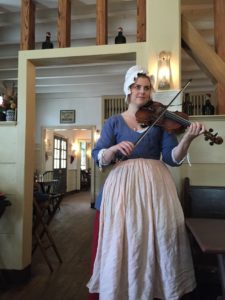
The Tavern: Dating back to 1779, The Tavern, located in Abingdon, Virginia, began as a stagecoach stop where travelers and locals could belly up to the bar, get a meal and settle in for the night. Considered the oldest in Virginia, The Tavern has hosted both the famous and infamous, from President Andrew Jackson to Louis Philippe, King of France, to wounded Union and Confederate civil war soldiers. No wonder the place is considered a hot bed of paranormal activity. The Tavern is considered one of Virginia’s most haunted taverns.
Over the years, The Tavern would change hands and serve as a variety of operations – from a bank, to a post office to a barber shop. In 1984, The Tavern was restored and returned to its original vocation, a tavern and restaurant. Since 1994, the menu has featured casual gourmet fare with a German accent, with Weiner schnitzel serving as the house specialty. And that’s OK, because I’m sure if one digs into The Tavern’s history long enough, one may well find it was frequented during the revolutionary war by Hessians, the Germans who fought for the British.
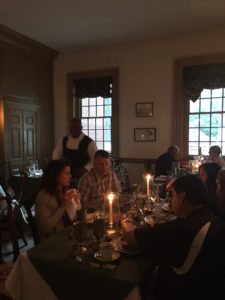
City Tavern: A stone’s throw from Independence Hall in Philadelphia sits the reconstructed City Tavern, a site where George Washington slept, ate and drank along with countless other American founding fathers and patriots. In fact, after the signing of the U.S. Constitution in 1787, delegates adjourned to imbibe at City Tavern, a location deemed by John Adams as America’s most genteel tavern.
After a fire that savaged the building in 1834 and years of decay, City Tavern was razed. It took an act of Congress to resurrect it, when in 1948, Independence National Historical Park was established, which included the site of City Tavern. It was rebuilt in 1976, and reopened in time for the bicentennial celebration. Since 1994, nationally known and Emmy Award-winning chef Walter Staib has operated the tavern, serving up 18th-century stylized gourmet fare based on 18th-century recipes. Beyond the recipes that fill the plates, the beers and ales are also brewed according to recipes attributed to George Washington, Benjamin Franklin and Thomas Jefferson.
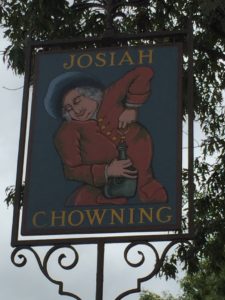
Josiah Chowning’s Tavern: This is another spot rebuilt on the footprint of a former tavern location found within the boundaries of Colonial Williamsburg. Chowning’s, whose reconstruction began in 1939, is one of four colonial taverns where visitors can savor the past. Chowning’s integrated the characteristics of 18th-century Virginia taverns into its design, modest in appearance, with its dining room and barroom set with plain wooden period-style tables, chairs and benches. Costumed servers carry plates and mugs to the hungry. Look for the Chowning’s sign – painted in the tradition of early signs—illustrating a man pulling a cork form a bottle, informing all who couldn’t read that drinks were found inside.
Chowning’s libations include stout rum drinks, a variety of ales and Virginia wines, as well as root beer and ginger ale, two popular colonial-era soft drinks that are still on the menu – all of which pairs nicely with a plate of the house specialty, Welsh Rarebit. A tavern menu mainstay of the era, Welsh Rarebit, which melds and melts together sharp cheddar cheese with seasoned mustard and spiced beer, is poured over toasted “sippets (bread points)” and served with or without a rasher or shavings of country-cured ham.
This week, I think I will fill a glass with a local beer and chow down on a little tavern fare. Here are two of my favorites – compliments of Colonial Williamsburg and Walter Staib at City Tavern.

CHOWNING’S TAVERN WELSH RAREBIT WITH BEER
Servings: 4
1 1/2 cup beer, divided
2 tablespoons cornstarch mixed with 1/2 cup of beer
1 tablespoon butter
1 pound sharp cheddar cheese, grated
Dash of cayenne pepper
1/2 teaspoon dry mustard
1/2 teaspoon salt
1/2 teaspoon Worcestershire sauce
2 to 3 thick slices sourdough or hearty white bread
2 to 4 thin slices of country-style ham, optional
Green onions, chopped for garnish
Simmer 1 cup of beer in a large stockpot over medium heat. Stir in dissolved cornstarch solution and return to simmer. Reduce heat to low. Add butter and cheese and stir until smooth. Add all remaining ingredients. Cut bread in half, on the diagonal, then cut once again to make bread points. Toast under a broiler. In ovenproof serving dish, place a few pieces of toast. Cover with cheese sauce and slice of ham, if desired, and brown quickly under broiler. Serve immediately, garnished with chopped green onions.
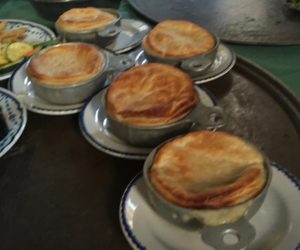
CITY TAVERN’S TURKEY POT PIE
1/2 cup vegetable oil
1 tablespoon fresh thyme, chopped, divided
3 tablespoons fresh parsley, chopped, divided
1 medium shallot, chopped, divided
4 cloves garlic, chopped, divided
1 whole 8-pound turkey
1 large white onion, diced
4 ribs celery, diced
2 large carrots, diced
1 cup dry white wine
1 quart turkey stock
1 cup fresh (or frozen) green peas
1 cup sliced button mushrooms
1 cup chopped red-skinned potatoes
2 cups heavy cream
Salt and freshly ground black, to taste
1/4 pound unsalted butter, softened
1/2 cup all-purpose flour
3 pounds puff pastry, cut in rounds to cover ramekins
1 large egg, beaten with 1 teaspoon water
In a small bowl, mix together oil and 1 1/2 teaspoons each thyme, parsley, shallot and garlic. Reserve remaining herbs. Rub oil and seasoning mixture over turkey. Place turkey on a tray, cover with plastic wrap and refrigerate overnight. Place turkey on a rack in a shallow roasting pan in oven, preheated to 450 F. Immediately reduce temperature to 350 F. Roast turkey for about 2 1/2 hours or until a meat thermometer inserted into the thigh reads 180 F. Remove turkey from the oven and let cool slightly.
Remove skin and meat from bones. Cut turkey meat into 1-inch pieces and reserve. Discard skin and bones. Discard all but 3 tablespoons pan drippings in the roasting pan. Heat drippings in pan on stove top. Add onion, celery and carrots and sauté over medium heat for 3 minutes, until tender. Add wine to deglaze pan, loosening any browned bits on pan. Add turkey stock, peas, mushrooms and potatoes. Bring to a boil over medium heat. Add heavy cream and reserved thyme, parsley, shallot and garlic. Season with salt and pepper to taste. Bring to a boil over high heat and add shredded turkey. Bring back to a boil. Reduce heat and simmer about 5 minutes, until ingredients are fully cooked. In a small bowl, combine the butter and flour into a paste. Slowly stir butter and flour mixture into turkey mixture until it is combined and thickened. Ladle turkey mixture into 8-ounce individual ramekins. Cover each with puff pastry circles, allowing a 1-inch overhang. Crimp pastry to edge of the bowl. Using a fork, gently prick pastry to allow steam to escape, being careful not to break the dough. Gently brush egg mixture over the surface of puff pastry. Bake in 350 F preheated oven for 12 to 15 minutes, until pastry edges are brown. Makes 16 pies.
Editor’s note. Pies can be wrapped and frozen for later use.





